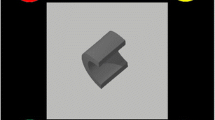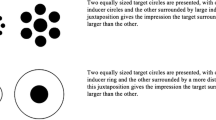Abstract
Understanding the relation between objects and their pictures at a level beyond mere feature discrimination is by no means a trivial cognitive ability, and support of this is still weak in nonhuman species. Here, we report evidence of representational insight in pigeons. Responding to pictures of human body parts was compared in birds that had extensive pre-experience with live humans and in birds that had never seen any human heads. In a two-alternative forced-choice procedure the pigeons were trained to discriminate between pictures of either handless or headless humans and nonhumans. On test, the birds had to choose (i) between body parts they had already seen in training and the parts that had been missing, (ii) between previously seen parts and arbitrary skin patches, and (iii) between previously missing parts and skin patches. Only the pigeons that lacked experience with real heads and were trained with pictures of headless humans failed to show a significant preference for pictures of missing parts (i.e., heads) over arbitrary skin patches. This demonstrates the importance of individual experience with the real 3D-referents of pictures for classification of the latter and is thereby evidence of representational insight.





Similar content being viewed by others
Notes
Of course, it would have been desirable to also raise pigeons without experience with “real” human hands. However, this was not done for practical reasons, as rendering the hands unrecognizable would have required a clumsy type of disguise which would have made cleaning, controlling of the nests, removal of broken eggs etc., almost impossible.
Graded judgements can nevertheless be made in 2AFC by calculating the proportion of trials in which a particular stimulus type is chosen in preference to another one. If a subject has a general and systematic preference for one type, it will choose it in a high proportion of trials, however small this bias may be in absolute terms.
Correction trials were excluded from analysis.
It may also be worth considering whether the differences between the Restricted and the Unrestricted pigeons regarding their age and/or their experimental histories may have influenced the results. However, the absence of any general differences in test performance between Restricted and Unrestricted birds argues against either of them playing a prominent role.
In addition, the small ns, which were 4 (Group Unrestricted No Heads) and 5 (Group Restricted No Heads), made it very difficult to achieve significance.
References
Aust U, Huber L (2001) The role of item- and category-specific information in the discrimination of people versus nonpeople images by pigeons. Anim Learn Behav 29:107–119
Aust U, Huber L (2002) Target-defining features in a “people-present/people-absent” discrimination task by pigeons. Anim Learn Behav 30:165–176
Aust U, Huber L (2003) Elemental versus configural perception in a people-present/people-absent discrimination task by pigeons. Learn Behav 31:213–224
Aust U, Huber L (2006) Picture–object recognition in pigeons: evidence of representational insight in a visual categorization task using a Complementary Information Procedure. J Exp Psychol: Anim Behav Proc 32:190–195
Beilin H (1999) Understanding the photographic image. J Appl Dev Psychol 20:1–30
Bovet D, Vauclair J (2000) Picture recognition in animals and humans. Behav Brain Res 109:143–165
Cabe PA (1976) Transfer of discrimination from solid objects to pictures by pigeons: a test of theoretical models of pictorial perception. Perc Psychophys 19:545–550
Cook RG, Wasserman EA (2006) Relational discrimination learning in pigeons. In: Zentall T, Wasserman EA (eds) Comparative cognition: experimental explorations of animal intelligence. Oxford University Press, Oxford, pp 307–324
Dasser V (1987) Slides of group members as representations of real animals (Macaca fascicularis). Ethology 76:65–73
D’Eath RB (1998) Can video images imitate real stimuli in animal behaviour experiments? Biol Rev 73:267–292
Delius JD (1992) Categorical discrimination of objects and pictures by pigeons. Anim Learn Behav 20:301–311
Delius JD, Emmerton J, Hörster W, Jäger R, Ostheim J (2000) Picture-object recognition in pigeons. In: Fagot J (ed) Picture perception in animals. Psychology Press Ltd, East Sussex, pp 1–35
DeLoache JS (1995) Early symbolic understanding and use. In: Medin D (ed) The psychology of learning and motivation, 33. Academic Press, New York, pp 65–114
DeLoache JS (2000) Dual representation and young children’s use of scale models. Child Dev 71:329–338
Fagot J, Martin-Malivel J, Dépy D (2000) What is the evidence for an equivalence between objects and pictures in birds and nonhuman primates? In: Fagot J (ed) Picture perception in animals. Psychology Press Ltd, East Sussex, pp 295–320
Ghosh N, Lea SEG, Noury M (2004) Transfer to intermediate forms following concept discrimination by pigeons: chimeras and morphs. J Exp Anal Behav 82:125–141
Greene S (1983) Feature memorization in pigeon concept formation. In: Commons ML, Herrnstein RJ, Wagner AR (eds) Quantitative analysis of behavior, vol 4. Ballinger, Cambridge, MA, pp 209–229
Hall G (1991) Perceptual and associative learning. Clarendon Press, Oxford
Herrnstein RJ, Loveland DH (1964) Complex visual concept in the pigeon. Science 146:549–551
Huber L, Troje NF, Loidolt M, Aust U, Grass D (2000) Natural categorization through multiple feature learning in pigeons. Quart J Exp Psychol 53B:343–357
Ittelson WH (1996) Visual perception of markings. Psychon Bull Rev 3:171–187
Kawai N, Kitaguchi K (1999) Evidence for within-compound learning in an instrumental conditioning with rats. Behav Proc 44:317–322
Lea SEG, Dittrich WH (2000) What do birds see in moving video images? In: Fagot J (ed) Picture perception in animals. Psychology Press Ltd, East Sussex, pp 143–180
Lechelt DP, Spetch ML (1997) Pigeons’ use of landmarks for spatial search in a laboratory arena and in digitized images of the arena. Learn Mot 28:424–445
Lombardi CM, Delius JD (1989) Pattern recognition invariance in pigeons: outline, colour and contrast. Int J Comp Psychol 2:83–102
Looney TA, Cohen PS (1974) Pictorial target control of schedule-induced attack in white carneaux pigeons. J Exp Anal Behav 21:571–584
Malott RW, Siddall JW (1972) Acquisition of the people concept in pigeons. Psychol Rep 31:3–13
Pearce JM (1987) A model for stimulus generalization in Pavlovian conditioning. Psychol Rev 94:61–73
Pearce JM (2002) Evaluation and development of a connectionist theory of configural learning. Anim Learn Behav 30:73–97
Pearce JM, Hall G (1979) Loss of associability by a compound stimulus comprising excitatory and inhibitory elements. J Exp Psychol: Anim Behav Proc 5:19–30
Pearce JM, Adam J, Wilson PN, Darby RJ (1992) Effects of discrimination training on responding during a compound conditioned stimulus. J Exp Psychol: Anim Behav Proc 18:379–386
Siegel RK, Honig WK (1970) Pigeon concept formation: successive and simultaneous acquisition. J Exp Anal Behav 13:385–390
Troje NF, Huber L, Loidolt M, Aust U, Fieder M (1999) Categorical learning in pigeons: the role of texture and shape in complex static stimuli. Vis Res 39:353–366
Wagner AR (2003) Context-sensitive elemental theory. Quart J Exp Psychol 56B:7–29
Watanabe S (1993) Object–picture equivalence in the pigeon: an analysis with natural concept and pseudoconcept discriminations. Behav Proc 30:225–232
Watanabe S (1997) Visual discrimination of real objects and pictures in pigeons. Anim Learn Behav 25:185–192
Watanabe S (2000) How do pigeons see pictures? Recognition of the real world from its 2-representation. In: Fagot J (ed) Picture perception in animals. Psychology Press Ltd, East Sussex, pp 71–90
Watanabe S, Lea SEG, Dittrich W (1993) What can we learn from experiments on pigeon concept discrimination? In: Zeigler HP, Bischof HJ (eds) Vision, brain, and behavior in birds. Cambridge MA, MIT Press, pp 351–367
Acknowledgments
The research was supported by the Austrian Science Foundation through Grant V3-B03 to Ulrike Aust and Grant P19574-B03 to Ludwig Huber. Thanks are due to Michael Steurer for developing all necessary computer software and for servicing the technical equipment, and to Johanna Kramer and Katharina Kramer for their assistance in the pigeon laboratory. Finally, we wish to thank Anna Wilkinson and Michael Steurer for valuable comments and discussion.
Author information
Authors and Affiliations
Corresponding author
Rights and permissions
About this article
Cite this article
Aust, U., Huber, L. Representational insight in pigeons: comparing subjects with and without real-life experience. Anim Cogn 13, 207–218 (2010). https://doi.org/10.1007/s10071-009-0258-4
Received:
Revised:
Accepted:
Published:
Issue Date:
DOI: https://doi.org/10.1007/s10071-009-0258-4




